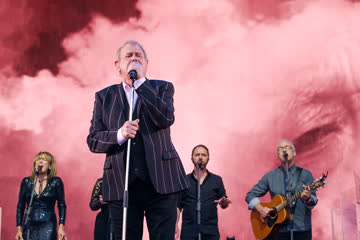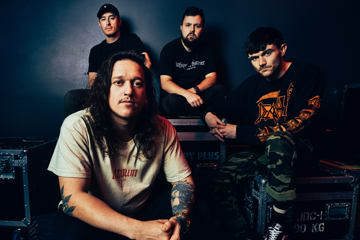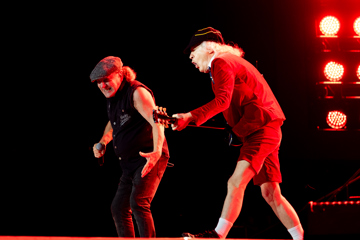'Baby Driver' Overcomes A Lack Of Substance With An Abundance Of Style
"A masterpiece of filmmaking craftsmanship, but it's not ... particularly meaningful."
BABY DRIVER

Of course there’s a wink for you. For anyone who associates Edgar Wright’s music-loving getaway driver with Noel Fielding, car-dancing in that original Mint Royale video — and not EDM power-balladeer and/or celebrity Knicks fan Ansel Elgort — don’t worry. Wright, the nerdiest film nerd this side of Quentin Tarantino, has got you covered. Not simply in the fact that the opening credits of Baby Driver are essentially a recreation of that old video-clip — only set, this time, to the Jon Spencer Blues Explosion’s Bellbottoms — with Elgort air-drumming to his heart’s content. But, later on in the film, if you’re watching carefully, a TV being flicked through the stations stops, momentarily, on one half o’ the Boosh, a getaway driver from 17 years ago (shoutout to dashboard-mounted Discmans!).
Turning a three-minute (and 31-second) pop promo into a feature-length movie seems like a perilous task, but Wright is up to it. And his logic is simple, and sound: the best way to turn a three-minute pop promo into a feature film is to make the movie one long, 113-minute music-video. Elgort’s titular character dances through the streets to Harlem Shuffle by Bob & Early, saunters to Easy by The Commodores, flees on foot in a wild chase to Hocus Pocus by Focus, and faces up to a final showdown to Never, Never Gonna Give Ya Up by Barry White. And, of course, Baby Driver by Simon & Garfunkel duly blasts out over the closing credits.
Don't miss a beat with our FREE daily newsletter
When Elgort and love-interest Lily James meet-cute, they discuss names in songs, soon each given their own soundtrack: B-A-B-Y by Carla Thomas and Debora by Tyrannosaurus Rex. And the musicians aren’t just on the soundtrack: there’s small roles handed to Flea and Sky Ferreira, cameos by Jon Spencer, Big Boi, and Killer Mike.
What’s most notable about the music in Baby Driver isn’t just the songs, but the way they’re a part of both the film’s world and its construction. Elgort’s Baby Driver is forever listening to music, plugged into a variety of bedazzled iPods; different devices used to suit different moods (the iPod’s wheel makes for a neat visual allusion to a steering wheel, too; and, later, Wright matches a shot of a laundromat machine turning to an overhead of vinyl spinning). Elgort glides through the film like a dancer; and is, it turns out, a real-life ballerino. He moves as if he’s in a musical: sliding down escalators in style, leaping stairs like a gazelle, making a sandwich with the grace of Fred Astaire.
It’s some of the most inspired movie-making of the year.
Wright choreographs his action sequences as if they’re song-and-dance numbers, both its leading man and the camera moving with balletic grace, tangible physicality. When there are car chases staged, they’re with real cars, in real locations, Baby Driver feeling like a sweet tonic for the CGI weightlessness that’s taken over most tentpole pictures. Its opening car chases play like a genre-geek’s beautiful dark twisted fantasy: all skids, slides, radical reversals, whiplash pans; a furious flurry of moments ripe with oh-no-they-didn’t audacity.
Wright and editors Paul Machliss and Jonathan Amos cut chases, crashes, and gunfire to the rhythm of the pop-songs the film employs. Or, even, make them become the rhythm themselves; the brassy clichés of Tequila turn sinister when paired with the added percussion of shots fired.
It’s some of the most inspired movie-making of the year; carrying the kind of snap, crackle, and panache that Wright delivered in his magnum opus, 2010’s Scott Pilgrim vs The World (which is, secretly, one of the truly great works of ’10s cinema). In fact, the smart-assery of this flick’s rapid-fire cuts — phones dialled and hung up, coats taken off hooks, shoes laced up, shit packed up, seatbelts buckled; all with cartoon-ish speed — is straight from the Pilgrim playbook.
As with Scott Pilgrim, Baby Driver embodies the influence of video games: each new job, new challenge, new getaway, new chase sequence like levelling up. The secret profundity of Scott Pilgrim vs The World — its adventure a symbolic journey where the immature male must learn to accept that the object of their affection has an entire romantic history; that she existed before you ever met her, and wasn’t just biding her time waiting for you to arrive — doesn’t get much play. In fact, whilst the romance with James mostly scans as pretty sweet, giddy with the thrill of new meeting, there’s also the moment where Cinderella says, to our hero-bro: "I’m here for you when you’re ready." Which makes her feel like the standard issue love-interest: ready, waiting, very available.
Wright tries to gin up some emotion, but most of the character-beats are plenty familiar. Our hero may be a getaway driver, but he’s a good kid! A tragic childhood accident left him with tinnitus, a washed-out-flashback-haunting dead mother (Ferreira) whom his new girlfriend resembles, and a constant source of trauma. He only broke bad because he ended up in foster homes thereafter. And, even then, he turned out okay: when not being a participant in bank robberies, he tends to an elderly blind man! After the opening heist, Baby swears he’s done, but just when he thought he was out, Kevin Spacey’s silver-tongued devil pulls him back in. For one last job! And if he doesn’t, the girl gets it!
Wright tries to gin up some emotion, but most of the character-beats are plenty familiar.
Jamie Foxx has a gay old time as the film’s chaos-agent, who doubts our titular driver ("You don’t need a score for a score" is a great line), and may be double-crossing him. Jon Hamm goes from Don-Draper’s-cokehead-black-sheep-son to unstoppable killing machine with relish. And Spacey delights in his every line, be he parrying incisive one-liners, or selling dialogue that’s knowingly dealing in action-movie cliché. But, as entertaining as they are, they all feel like cartoon characters. When Elgort is driven to the brink, or bad shit starts going down, there’s no real weight, no pathos.
Baby Driver is comparable to La La Land in many ways: each is a modern-day musical, in which a love-story is set against a candy-coloured backdrop, and a valentine for old-fashioned movie entertainment is floated. But Damien Chazelle matched his own gymnastic camera moves, rhythmic cuts, and toe-tappin’ tunes to a story shot through with real heart and humanity, imbued with the sadness of dying dreams and time passing. In contrast, in Baby Driver, when the going gets tough, Wright just pulls out more guns.
It’s a small critique, but a notable one: Baby Driver is a masterpiece of filmmaking craftsmanship, but it’s not a particularly meaningful piece of art.







